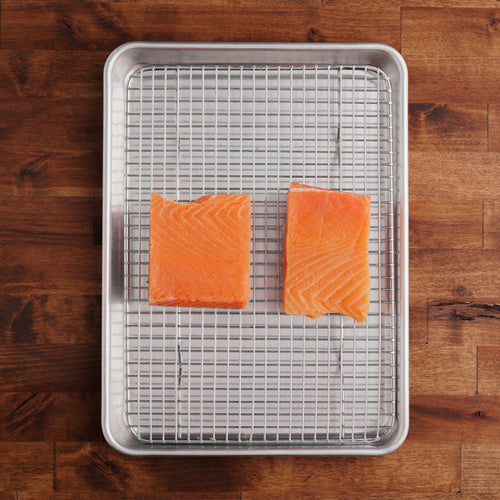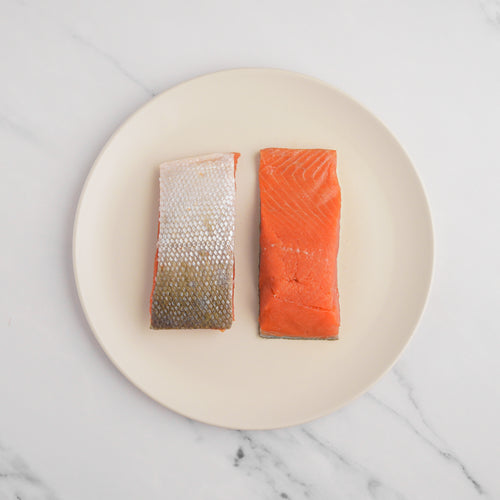
How to Cook Salmon
Salmon is one of the most popular fish in the U.S. This top selling fish is known for its distinctive flavor, rich texture and health benefits. This unique fish is an excellent source of Omega-3 fatty acids which are good for your heart, brain and eyesight.
Most of all, salmon is just plain delicious. Discover more about the types of salmon offered by Snake River Farms and how to prepare this amazing fish.
Types of Salmon
Take a look at your local seafood counter and you’ll see more than one kind salmon. There are five primary salmon species commonly found at the market – chinook (also called king), coho, pink, sockeye and Atlantic. Each type of salmon has unique characteristics including color, fat content and texture. We’ll talk about the specific traits of the three species SRF offers below.
Another important factor to consider when buying salmon where it is harvested. The two options are farmed raised or sourced in the wild. Wild-caught salmon provides the best of all worlds. It has superior flavor, texture, natural color, and is a sustainable since it is raised in the natural coastal fisheries which are carefully monitored and maintained.
Nutritionally, farmed salmon has more fat, but wild salmon contains a higher amounts of Omega-3 fatty acids and naturally occurring minerals like iron and calcium. Wild salmon has a pronounced natural color, while farmed salmon is fed supplements to boost the color of the flesh. All salmon on the SRF website is wild-caught.
All farm-raised salmon is the species Salmo salar, also known as Atlantic salmon. Commercial salmon farming operations are located around the world. The two largest producers are Norway and Chile. Just like beef ranches some salmon farms are better than others. Third-party entities exist to certify farmed salmon based on quality and sustainability.
1. Coho Salmon
Coho salmon, also known as silver salmon, has a lighter red-orange color and a lower fat content than sockeye and king salmon. Coho has a medium fat content with a mild, subtle flavor that’s slightly sweet. Coho salmon’s texture is medium firm, with a gentle bite.
In the wild, coho are a dark metallic blue or greenish color and their backs with silver sides and a light colored belly. These salmon are generally smaller in size, so they are a good source of larger cuts, like the 1.8 lb. fillets available from SRF.
2. Sockeye Salmon
Sockeye salmon is sometimes referred to as red salmon, due to its bright red-orange flesh and savory rich flavor. The skin of sockeye salmon also turns a deep red hue as the migratory fish travels upstream to spawn. When you find sockeye in the seafood counter, the skin is sliver since the wild-caught fish are caught in the ocean.
Sockeye is a small variety of Pacific salmon with an average weight of 10 pounds. This species is celebrated for its firm texture and rich flavor. Wild caught sockeye has a high level of flavorful fat which ranks just behind the fat content found in King salmon.
3. King Salmon
Known as Chinook Salmon, the King Salmon is the largest Pacific salmon species. King salmon weigh about 40 pounds but can be as large as 80 pounds. Known for its deep red color, king salmon has a high level of rich oil. Its omega-3 fatty acid levels are twice as high as sockeye.
King salmon has succulent flesh with delicate, large flakes and a buttery texture. Its flavor is rich, but milder compared to sockeye, making it an ideal choice for palates that prefer a more mild profile.
Salmon Internal Temperature
The natural fat content of salmon provides great flavor and makes it more heat resistant than leaner fish. Regardless, it’s important to know the best internal temperature for salmon cooked to perfection. No matter the cooking method used, carefully monitor the temperature to avoid overcooked and dry fish.
Chefs recommend, and we agree, the ideal temperature for salmon is 125°F. This is a medium level of doneness that is rich and moist with gently flaking salmon. Cooking to a temperature higher than 130°F. can produce dry, overly firm results.
Salmon is a fish that some prefer seared with a cool center. If you prefer rare, cook to a temperature of at least 120°F.
Grilled Salmon
- Grilled salmon is a summertime stand-by. Since salmon has a higher oil content than many fish, it holds up well to this cooking method. Salmon’s rich flavor does not require anything more than simple seasonings and the bright burst of fresh lemon.
- An easy grilling method for salmon filets is to cook them skin side down and allow them to cook without flipping. This develops a crispy skin and eliminates concerns of fish sticking to the grill.
- Fully defrost salmon filets in the refrigerator for at least 8 hours.
- Pat filets dry and brush both sides generously with olive oil. Season with salt and pepper on both sides of the fillets
- Set your grill up for 2-zone cooking with a hot side and a cool side. Heat clean grill to medium/high (about 400°F). Lightly season the grill with paper towels dipped in a high smoke point vegetable oil (avocado and grapeseed are good) to help prevent sticking.
- Place salmon on the grill, skin side down on the cool side and close the lid. Cook until the skin is light brown and the flesh is opaque. Total grilling time will be about 10 minutes, but open the lid and check the temperature after about 5 minutes.
- Continue to monitor the temperature and remove salmon from the grill when it reaches 125°F.
- Allow to rest 5 minutes. Squeeze fresh lemon juice on top and serve.
Baked Salmon in Parchment
- Cooking salmon in parchment (en papillote) is a French technique that steam cooks the fish with wonderfully moist and tender results. The finished dish resembles poached salmon and captures all the natural juices of the fish.
- Fully defrost the salmon in the refrigerator for at least 8 hours.
- Heat oven to 400°F.
- Cut baking parchment into a rectangular about three times longer than the salmon filets. You will need one piece of parchment for each filet.
- Place a ½ tablespoon of butter in the middle of the parchment. Place salmon on top. Brush filets with olive oil and season with salt and pepper. Place thin slices of lemon on top. Finish with a sprinkle of chopped green onion.
- Pull up the two longest ends of the parchment up and fold them two to three times. Close with paper clips. Roll the two ends of the parchment to seal them and close with more paper clips.
- Set the parchment packets on a baking sheet and place in the oven. Bake for until the internal temperature reached 125°F (about 9 to 10 minutes). The salmon filets should be opaque and the flesh just beginning to flake.
- Checking the temperature of the salmon is more of a challenge with this method. Go ahead and poke the thermometer probe through the parchment after about 6 or 7 minutes.
Air Fryer Salmon
- The air fryer has quickly become a kitchen equipment staple and we receive frequent requests for prep methods using this time saving appliance. This method produces results that resembles pan seared salmon – a moist interior and crisp exterior. Air fryers cook food quickly, so check internal temp early and often to prevent overcooking.
- Fully defrost the salmon in the refrigerator for at least 8 hours.
- Pat filets dry and brush with olive oil. Season with salt and pepper.
- Set air fryer to 400°F. When hot, place filet in the basket skin side down. Total cook time is 7 to 8 minutes. After 5 minutes, check the salmon internal temperature. The target is 125°F.
- When the filets reach 125°F. remove from air fryer. Season with fresh lemon juice and serve.
How to Cook Frozen Salmon
Forget to thaw your salmon the night before? It is possible to cook salmon filets from frozen with good results. Here are two different methods to try when you’re in a time crunch.
BAKED SALMON – Frozen Salmon
- Brush filets with olive oil and season with salt and pepper. Arrange the filets in an ovenproof baking dish.
- Seal the baking dish with foil. This provides an enclosed environment to thaw the fish and retain its moisture. Bake for 15 minutes.
- Remove foil and bake until the internal temperature reaches 125°F (about 9 to 10 minutes).
- Let rest for 3 to 4 minutes. Serve with lemon wedges.
AIR FRYER – Frozen Salmon
- Pat filets dry and brush with olive oil. Season with salt and pepper.
- Set air fryer to 400°F. When hot, place filet in the basket skin side down. Total cook time is 7 to 8 minutes. After 5 minutes, check the salmon internal temperature. The target is 125°F.
Our Favorite Salmon Recipes
- Honey Garlic Glazed Salmon
Sweet and savory honey and garlic glazed salmon is a favorite. The glaze comes together quickly and coats the salmon before baking it in the oven. The salmon is flavorful and delicious and great accompanied by a salad or sautéed greens for a quick and impressive meal.
> Learn More
- Basic Grilled King Salmon
A fast way to cook our King Salmon is to use a skillet or grill. Brush with olive oil and season with salt and pepper. Cook the fillets, skin side down over medium high until the skin is crisp, then flip over and finish for two more minutes.
> Learn More
Salmon is a dish that is loved by many due to its rich flavor and health benefits. It’s easy to prepare using a wide number of preparation methods and is the centerpiece of quick meals or more formal dinners. A beautiful protein by itself, but try it alongside a Snake River Farms steak for a simple Surf & Turf.





